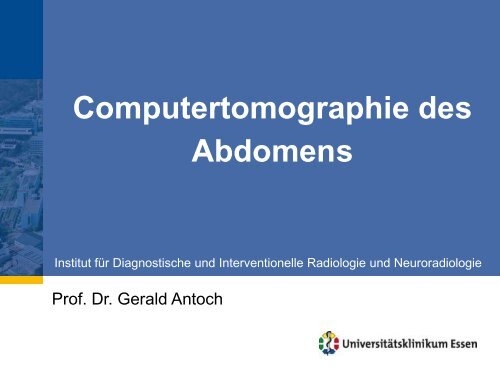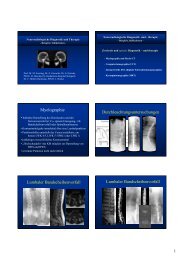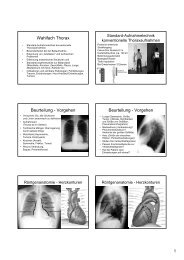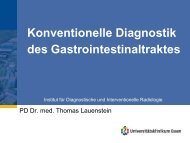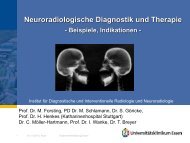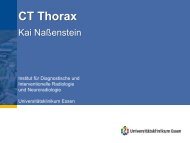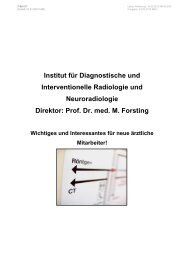Computertomographie des Abdomens
Computertomographie des Abdomens
Computertomographie des Abdomens
Erfolgreiche ePaper selbst erstellen
Machen Sie aus Ihren PDF Publikationen ein blätterbares Flipbook mit unserer einzigartigen Google optimierten e-Paper Software.
<strong>Computertomographie</strong> <strong>des</strong><br />
<strong>Abdomens</strong><br />
Institut für Diagnostische und Interventionelle Radiologie und Neuroradiologie<br />
Prof. Dr. Gerald Antoch
Übersicht<br />
• Was stellt die CT dar?<br />
• Kontrastmittel<br />
• Gefäßerkrankungen<br />
• Leber und Gallenblase<br />
• Niere<br />
• Magen-Darm<br />
• Pankreas<br />
Folie 2<br />
Titel<br />
2 23.11.2010 | Prof. Dr. Gerald Antoch<br />
<strong>Computertomographie</strong> <strong>des</strong> <strong>Abdomens</strong>
Gewebsdichte: CT-Wert /HE<br />
CT = 1000 * (µ - µ H2O) / µH2O<br />
µ = Röntgenschwächung<br />
Hounsfield:<br />
HE<br />
H 2 O<br />
Luft<br />
Folie 3<br />
Titel<br />
3 23.11.2010 | Prof. Dr. Gerald Antoch<br />
<strong>Computertomographie</strong> <strong>des</strong> <strong>Abdomens</strong>
Bildbeschreibung<br />
•Bildinterpretation und –beschreibung basierend auf den Dichtwerten<br />
hypodens<br />
isodens<br />
hyperdens<br />
Folie 4<br />
Titel<br />
4 23.11.2010 | Prof. Dr. Gerald Antoch<br />
<strong>Computertomographie</strong> <strong>des</strong> <strong>Abdomens</strong>
Gewebsdichte: CT-Wert / HE<br />
Folie 5<br />
Titel<br />
5 23.11.2010 | Prof. Dr. Gerald Antoch<br />
<strong>Computertomographie</strong> <strong>des</strong> <strong>Abdomens</strong>
Übersicht<br />
• Was stellt die CT dar?<br />
• Kontrastmittel<br />
• Gefäßerkrankungen<br />
• Leber und Gallenblase<br />
• Niere<br />
• Magen-Darm<br />
• Pankreas<br />
Folie 6<br />
Titel<br />
6 23.11.2010 | Prof. Dr. Gerald Antoch<br />
<strong>Computertomographie</strong> <strong>des</strong> <strong>Abdomens</strong>
Orale Kontrastmittel<br />
Differenzierung Darm / umgebende Strukturen<br />
Folie 7<br />
Titel<br />
7 23.11.2010 | Prof. Dr. Gerald Antoch<br />
<strong>Computertomographie</strong> <strong>des</strong> <strong>Abdomens</strong>
Negative orale Kontrastmittel<br />
Wasser, (Luft)<br />
gute Darstellung<br />
Magen- und Darmwand<br />
gute Abgrenzung<br />
Duodenum/ Pankreaskopf<br />
schnelle Resorption aus<br />
Dünndarm<br />
Pankreas, Magen<br />
Folie 8<br />
Titel<br />
8 23.11.2010 | Prof. Dr. Gerald Antoch<br />
<strong>Computertomographie</strong> <strong>des</strong> <strong>Abdomens</strong>
Positive orale Kontrastmittel<br />
Jod, Barium<br />
gute Abgrenzbarkeit Darm<br />
schlechte Abgrenzbarkeit<br />
Darmwand<br />
Alle Indikationen außer<br />
Pankreas und Magen<br />
Barium kontraindiziert bei<br />
V.a. Perforation /postop.<br />
Folie 9<br />
Titel<br />
9 23.11.2010 | Prof. Dr. Gerald Antoch<br />
<strong>Computertomographie</strong> <strong>des</strong> <strong>Abdomens</strong>
IV Kontrastmittel<br />
1. Läsionsdetektion /<br />
Charakterisierung<br />
2. Abgrenzung<br />
Gefäße / Pathologie<br />
3. Gefäßdiagnostik (CTA)<br />
Folie 10<br />
Titel<br />
10 23.11.2010 | Prof. Dr. Gerald Antoch<br />
<strong>Computertomographie</strong> <strong>des</strong> <strong>Abdomens</strong>
IV Kontrastmittel<br />
• Jodhaltige, nicht-ionische Substanzen<br />
• relativ gute Verträglichkeit<br />
• leichte allerg. Reaktionen: 4-10/100<br />
• schwere allerg. Reaktionen: 1/25000<br />
• renale Elimination<br />
Folie 11<br />
Titel<br />
11 23.11.2010 | Prof. Dr. Gerald Antoch<br />
<strong>Computertomographie</strong> <strong>des</strong> <strong>Abdomens</strong>
Kontrastmittelreaktionen<br />
Frühreaktionen (bis 30 min p.i.):<br />
• Leicht: Übelkeit/ Erbrechen/ Urtikaria<br />
• Schwer: Dyspnoe/ RR / Herzstillstand<br />
Spätreaktion (30 min bis 2 d p.i.):<br />
• Hautveränderungen (Rötung, Juckreiz)<br />
• Kopfschmerz, Übelkeit, grippe-ähnlich<br />
Folie 12<br />
Titel<br />
12 23.11.2010 | Prof. Dr. Gerald Antoch<br />
<strong>Computertomographie</strong> <strong>des</strong> <strong>Abdomens</strong>
IV Kontrastmittel<br />
Cave:<br />
• Niereninsuffizienz ( Kreatinin)<br />
• Allergie ( Anamnese)<br />
• Hyperthyreose ( TSH, T3, T4)<br />
• Diabetes mit Metforminmedikation<br />
Folie 13<br />
Titel<br />
13 23.11.2010 | Prof. Dr. Gerald Antoch<br />
<strong>Computertomographie</strong> <strong>des</strong> <strong>Abdomens</strong>
Übersicht<br />
• Was stellt die CT dar?<br />
• Kontrastmittel<br />
• Gefäßerkrankungen<br />
• Leber und Gallenblase<br />
• Niere<br />
• Magen-Darm<br />
• Pankreas<br />
Folie 14<br />
Titel<br />
14 23.11.2010 | Prof. Dr. Gerald Antoch<br />
<strong>Computertomographie</strong> <strong>des</strong> <strong>Abdomens</strong>
Aneurysma<br />
• Aneurysma verum<br />
• häufigste Form<br />
• Aussackung aller 3<br />
Wandschichten<br />
• in 85% infrarenal<br />
• häufig randständige<br />
Thromben<br />
Folie 15<br />
Titel<br />
15 23.11.2010 | Prof. Dr. Gerald Antoch<br />
<strong>Computertomographie</strong> <strong>des</strong> <strong>Abdomens</strong>
Aneurysma<br />
Akute Ruptur<br />
Alte Ruptur<br />
Folie 16<br />
Titel<br />
16 23.11.2010 | Prof. Dr. Gerald Antoch<br />
<strong>Computertomographie</strong> <strong>des</strong> <strong>Abdomens</strong>
Übersicht<br />
• Was stellt die CT das?<br />
• Kontrastmittel<br />
• Gefäßerkrankungen<br />
• Leber und Gallenblase<br />
• Niere<br />
• Magen-Darm<br />
• Pankreas<br />
Folie 17<br />
Titel<br />
17 23.11.2010 | Prof. Dr. Gerald Antoch<br />
<strong>Computertomographie</strong> <strong>des</strong> <strong>Abdomens</strong>
45 j. m.: Alkoholiker<br />
Folie 18<br />
Titel<br />
18 23.11.2010 | Prof. Dr. Gerald Antoch<br />
<strong>Computertomographie</strong> <strong>des</strong> <strong>Abdomens</strong>
45 j. m.: Alkoholiker<br />
CT- Leberzirrhose:<br />
• unregelmäßige Oberfläche<br />
• Hypertrophie li. LL und Lobus<br />
caudatus<br />
• Weite Pfortader > 12mm<br />
• Aszites<br />
• Splenomegalie<br />
• portocavale Kollateralen<br />
Folie 19<br />
Titel<br />
19 23.11.2010 | Prof. Dr. Gerald Antoch<br />
<strong>Computertomographie</strong> <strong>des</strong> <strong>Abdomens</strong>
55 j. m.: Leberzirrhose<br />
1<br />
2<br />
1<br />
Leberläsion 1: scharf abgrenzbar, hypodens,<br />
Leberzyste<br />
keine KM-Aufnahme<br />
Leberläsion 2: unscharf abgrenzbar, isodens,<br />
früharterielle KM-Aufnahme<br />
Hepatozelluläres<br />
Karzinom (HCC)<br />
Folie 20<br />
Titel<br />
20 23.11.2010 | Prof. Dr. Gerald Antoch<br />
<strong>Computertomographie</strong> <strong>des</strong> <strong>Abdomens</strong>
Leberfiliae<br />
Leberfiliae von Adenokarzinomen <strong>des</strong> Magen-Darm Traktes:<br />
• meist hypodens in venöser Phase<br />
• ggf. randständige KM-Aufnahme<br />
Folie 21<br />
Titel<br />
21 23.11.2010 | Prof. Dr. Gerald Antoch<br />
<strong>Computertomographie</strong> <strong>des</strong> <strong>Abdomens</strong>
Leberfiliae<br />
Hypervaskularisierte Filiae:<br />
Arterielle KM-Aufnahme<br />
• neuroendokrine Tumore<br />
• Niere<br />
• Schilddrüse<br />
Folie 22<br />
Titel<br />
22 23.11.2010 | Prof. Dr. Gerald Antoch<br />
<strong>Computertomographie</strong> <strong>des</strong> <strong>Abdomens</strong>
24 j. w.: RF der Leber<br />
Irisblendenphänomen:<br />
Zentripetale<br />
KM-Aufnahme<br />
Hämangiom<br />
Folie 23<br />
Titel<br />
23 23.11.2010 | Prof. Dr. Gerald Antoch<br />
<strong>Computertomographie</strong> <strong>des</strong> <strong>Abdomens</strong>
25j. w.: Lebertumor<br />
FHN:<br />
• frühart. KM-Aufnahme<br />
• zentrale Narbe<br />
CT<br />
MRT<br />
Folie 24<br />
Titel<br />
24 23.11.2010 | Prof. Dr. Gerald Antoch<br />
<strong>Computertomographie</strong> <strong>des</strong> <strong>Abdomens</strong>
62 j. m.: OBB-Schmerzen<br />
Cholezystolithiasis<br />
Folie 25<br />
Titel<br />
25 23.11.2010 | Prof. Dr. Gerald Antoch<br />
<strong>Computertomographie</strong> <strong>des</strong> <strong>Abdomens</strong>
71 j. m.: OB-Schmerzen<br />
Cholezystitis:<br />
• Akute Cholezystitis<br />
• Gedeckte Perforation<br />
• Verdickung der Wand (> 4-7mm)<br />
• dreischichtige Wand<br />
• perifokaler Flüssigkeitsraum<br />
Folie 26<br />
Titel<br />
26 23.11.2010 | Prof. Dr. Gerald Antoch<br />
<strong>Computertomographie</strong> <strong>des</strong> <strong>Abdomens</strong>
Übersicht<br />
• Was stellt die CT dar?<br />
• Kontrastmittel<br />
• Gefäßerkrankungen<br />
• Leber und Gallenblase<br />
• Niere<br />
• Magen-Darm<br />
• Pankreas<br />
Folie 27<br />
Titel<br />
27 23.11.2010 | Prof. Dr. Gerald Antoch<br />
<strong>Computertomographie</strong> <strong>des</strong> <strong>Abdomens</strong>
55 j. m.: Blutiger Urin<br />
Nierenzellkarzinom<br />
Folie 28<br />
Titel<br />
28 23.11.2010 | Prof. Dr. Gerald Antoch<br />
<strong>Computertomographie</strong> <strong>des</strong> <strong>Abdomens</strong>
Nierenzellkarzinom?<br />
Niereninfarkt!<br />
Folie 29<br />
Titel<br />
29 23.11.2010 | Prof. Dr. Gerald Antoch<br />
<strong>Computertomographie</strong> <strong>des</strong> <strong>Abdomens</strong>
28 j. m.: Flankenschmerzen rechts<br />
native CT bei V.a. Urolithiasis<br />
prox. Ureterkonkrement<br />
Folie 30<br />
Titel<br />
30 23.11.2010 | Prof. Dr. Gerald Antoch<br />
<strong>Computertomographie</strong> <strong>des</strong> <strong>Abdomens</strong>
Übersicht<br />
• Was stellt die CT dar?<br />
• Kontrastmittel<br />
• Gefäßerkrankungen<br />
• Leber und Gallenblase<br />
• Niere<br />
• Magen-Darm<br />
• Pankreas<br />
Folie 31<br />
Titel<br />
31 23.11.2010 | Prof. Dr. Gerald Antoch<br />
<strong>Computertomographie</strong> <strong>des</strong> <strong>Abdomens</strong>
73 j. w.: Blut im Stuhl<br />
Colonkarzinom<br />
Folie 32<br />
Titel<br />
32 23.11.2010 | Prof. Dr. Gerald Antoch<br />
<strong>Computertomographie</strong> <strong>des</strong> <strong>Abdomens</strong>
57 j. m.: Schmerzen li. Unterbauch<br />
Sigmadivertikulitis<br />
Folie 33<br />
Titel<br />
33 23.11.2010 | Prof. Dr. Gerald Antoch<br />
<strong>Computertomographie</strong> <strong>des</strong> <strong>Abdomens</strong>
65 j. m.: Hemicolektomie li. Fieber<br />
Abszeß<br />
• Flüssigkeitsisodense Läsion<br />
• Lufteinschlüsse<br />
• Randständige Kontrastmittelaufnahme<br />
Folie 34<br />
Titel<br />
34 23.11.2010 | Prof. Dr. Gerald Antoch<br />
<strong>Computertomographie</strong> <strong>des</strong> <strong>Abdomens</strong>
Übersicht<br />
• Was stellt die CT dar?<br />
• Kontrastmittel<br />
• Gefäßerkrankungen<br />
• Leber und Gallenblase<br />
• Niere<br />
• Magen-Darm<br />
• Pankreas<br />
Folie 35<br />
Titel<br />
35 23.11.2010 | Prof. Dr. Gerald Antoch<br />
<strong>Computertomographie</strong> <strong>des</strong> <strong>Abdomens</strong>
Normales Pankreas<br />
Folie 36<br />
Titel<br />
36 23.11.2010 | Prof. Dr. Gerald Antoch<br />
<strong>Computertomographie</strong> <strong>des</strong> <strong>Abdomens</strong>
39 j. w.: Alkoholikerin<br />
Akute Pankreatitis<br />
• Ödematöse Auftreibung (hypodens)<br />
• Schlechte Abgrenzbarkeit zur Umgebung<br />
• Nektrosestraße<br />
Folie 37<br />
Titel<br />
37 23.11.2010 | Prof. Dr. Gerald Antoch<br />
<strong>Computertomographie</strong> <strong>des</strong> <strong>Abdomens</strong>
58 j. m.: rez. OBB Schmerzen<br />
Chron. Pankreatitis<br />
• Pankreasatrophie<br />
• Verkalkungen, Gangektasien<br />
• Pseudozysten<br />
Folie 38<br />
Titel<br />
38 23.11.2010 | Prof. Dr. Gerald Antoch<br />
<strong>Computertomographie</strong> <strong>des</strong> <strong>Abdomens</strong>
61 j. m.: schmerzloser Ikterus<br />
Pankreas CA<br />
Folie 39<br />
Titel<br />
39 23.11.2010 | Prof. Dr. Gerald Antoch<br />
<strong>Computertomographie</strong> <strong>des</strong> <strong>Abdomens</strong>
Zusammenfassung<br />
• Dichtwerte in Hounsfield Einheiten<br />
• Kontrastmittel verbessern Läsionsdetektion<br />
• Barium: nicht bei Perforation oder perioperativ<br />
• IV KM: allergische Früh- und Spätreaktionen<br />
• IV KM: Kontraindikationen beachten<br />
•Strahlenbelastung: Bei jungen Par. Ohne Malignom strenge<br />
Indikationsstellung (ggf. MRT)<br />
Folie 40<br />
Titel<br />
40 23.11.2010 | Prof. Dr. Gerald Antoch<br />
<strong>Computertomographie</strong> <strong>des</strong> <strong>Abdomens</strong>
69 j. m.: Leberzirrhose<br />
Pfortaderthrombose<br />
Folie 41<br />
Titel<br />
41 23.11.2010 | Prof. Dr. Gerald Antoch<br />
<strong>Computertomographie</strong> <strong>des</strong> <strong>Abdomens</strong>
24 j. m.: von Auto angefahren, Bauchschmerzen<br />
Traumatische Leberlazeration<br />
Folie 42<br />
Titel<br />
42 23.11.2010 | Prof. Dr. Gerald Antoch<br />
<strong>Computertomographie</strong> <strong>des</strong> <strong>Abdomens</strong>
39 j. w.: hepatisch met. Colon-Ca, Miserere<br />
• Mechanischer Dünndarmileus<br />
• Peritonealkarzinose<br />
Folie 43<br />
Titel<br />
43 23.11.2010 | Prof. Dr. Gerald Antoch<br />
<strong>Computertomographie</strong> <strong>des</strong> <strong>Abdomens</strong>
CT-Colonographie, 3D<br />
Folie 44<br />
Titel<br />
44 23.11.2010 | Prof. Dr. Gerald Antoch<br />
<strong>Computertomographie</strong> <strong>des</strong> <strong>Abdomens</strong>
Graustufenkodierung<br />
• Das menschliche Auge kann nur 40 – 100 Graustufen<br />
unterscheiden<br />
Fenstertechnik<br />
• Dichte innere Organe/ pathologischer Veränderungen<br />
sehr ähnlich (30-70 HE)<br />
Kontrastmittel<br />
Folie 45<br />
Titel<br />
45 23.11.2010 | Prof. Dr. Gerald Antoch<br />
<strong>Computertomographie</strong> <strong>des</strong> <strong>Abdomens</strong>
CT-gesteuerte Abszeßdrainage<br />
Folie 46<br />
Titel<br />
46 23.11.2010 | Prof. Dr. Gerald Antoch<br />
<strong>Computertomographie</strong> <strong>des</strong> <strong>Abdomens</strong>
CT-gesteuerte Abszeßdrainage<br />
Folie 47<br />
Titel<br />
47 23.11.2010 | Prof. Dr. Gerald Antoch<br />
<strong>Computertomographie</strong> <strong>des</strong> <strong>Abdomens</strong>
CT-gesteuerte Abszeßdrainage<br />
Folie 48<br />
Titel<br />
48 23.11.2010 | Prof. Dr. Gerald Antoch<br />
<strong>Computertomographie</strong> <strong>des</strong> <strong>Abdomens</strong>
52 j. m.: Akutes Abdomen<br />
Rupturiertes Aneurysma<br />
der A. lienalis<br />
Folie 49<br />
Titel<br />
49 23.11.2010 | Prof. Dr. Gerald Antoch<br />
<strong>Computertomographie</strong> <strong>des</strong> <strong>Abdomens</strong>
52 j. m.: Akutes Abdomen<br />
Rupturiertes Aneurysma<br />
der A. lienalis<br />
Folie 50<br />
Titel<br />
50 23.11.2010 | Prof. Dr. Gerald Antoch<br />
<strong>Computertomographie</strong> <strong>des</strong> <strong>Abdomens</strong>
52 j. m.: Akutes Abdomen<br />
Rupturiertes Aneurysma<br />
der A. lienalis<br />
Folie 51<br />
Titel<br />
51 23.11.2010 | Prof. Dr. Gerald Antoch<br />
<strong>Computertomographie</strong> <strong>des</strong> <strong>Abdomens</strong>
52 j. m.: Akutes Abdomen<br />
Rupturiertes Aneurysma<br />
der A. lienalis<br />
Folie 52<br />
Titel<br />
52 23.11.2010 | Prof. Dr. Gerald Antoch<br />
<strong>Computertomographie</strong> <strong>des</strong> <strong>Abdomens</strong>
66 j. m.: Unklare UB-Schmerzen<br />
• Akute Appendizitis<br />
• Gedeckte Perforation<br />
Folie 53<br />
Titel<br />
53 23.11.2010 | Prof. Dr. Gerald Antoch<br />
<strong>Computertomographie</strong> <strong>des</strong> <strong>Abdomens</strong>


